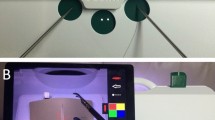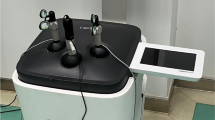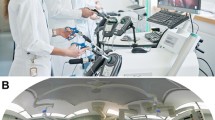Abstract
Background:
This study was undertaken to investigate operating room performance of surgical residents, after participating in the Eindhoven virtual reality laparoscopic cholecystectomy training course. This course is the first formal surgical resident trainings course, using a variety of complementary virtual reality (VR) skills training simulation in order to prepare surgical residents for their first laparoscopic cholecystectomy. The course was granted EAES certification.
Methods:
The four-day course is based on multimedia and multimodality approach. A variety of increasingly difficult simulation training sessions, next to intimate focus-group “knowledge sessions” are included. Both basic and procedural VR simulation is featured, using MIST-VR and the Xitacts' LapChol simulation software. The operating room performance of twelve surgical residents who participated in the course and twelve case-control counterparts were compared. The case-control grup was matched for clinical number laparoscopic cholecystectomy performance (maximum of 4 procedures). Two observers analyzed a randomly mixed videotape, featuring the part of the “clip-and-cut” procedure of the laparoscopic cholecystectomy, and were blinded for participants' group status. Structured questionnaires including multiple observation scales were used to assess performance.
Results:
Residents of both the experimental and control group did not differ in demographic parameters, except for number of laparoscopic cholecystectomies in favor of the control group (p-value 0.008). Both observers judge the experimental group to perform significantly better (p-value 0.004 and 0.013). Experimental group residents valued their course highly in terms of their laparoscopic surgical skills improvement and the use of VR simulators in the surgical curiculum.
Conclusions:
The Eindhoven Virtual Reality laparoscopic cholecyctectomy training course improves surgical skill in the operating room above the level of residents trained by a variety of other training methods.




Similar content being viewed by others
References
Ahlberg G, Heikkinen T, Iselius L, Leijonmarck CE, Rutqvist J (2002) Does training in a virtual reality simulator improves surgical performance? Surg Endosc 16: 126–129
Bridges M, Diamond DL (1989) The financial impact of teaching surgical residents in the operating room. Am J Surg 210: 118–121
Eubanks TR (1999) An objective scoring system for laparoscopic cholecystectomy. J Am Coll Surg 189: 556–574
Grantcharov TP, Kristiansen VB, Bendix J, Bardram L, Rosenberg J (2004) Randomized clinical trail of virtual reality simulation for laparoscopic skills training. Br J Surg 91: 146–150
Hamilton EC, Scott DJ, Fleming RV, Rege RV, Laycock R (2002) Comparsion of video trainer and virtual reality training systems on acquisition of laproscopic skill. Surg Endos 16: 406–411
Hyltander A, Liljegren E, Rhodin PH, Lonroth H (2002) The transfer of basic skills learned in a laparoscopic simulator to the operating room. Surg Endosc 16: 1324–1328
Rossner JC, Rossner LE, Savalgi RS (1997) Skill acquisition and assessment for laparoscopic surgery Arch Surg 132: 200–204
Rossner JC, Rossner LE, Savalgi RS (1998) Objective evaluation of laparoscopic surgical skill program for residents and senior surgeons. Arch Surg 133: 657–461
Schijven M, Jakimowicz J (2002) Face, expert, and referent validity of the Xitact LS500 Laparoscopy Simulator. Surg Endosc 16: 1764–1770
Schijven M, Jakimowicz J (2003) Construct validity: experts and residents performing on the Xitact LS500 laparoscopy simulator. Surg Endosc 17: 803–810
Schijven M, Jakimowicz J (2003) Virtual reality surgical laparoscopic simulators: how to choose. Surg Endsc 17: 1943–1950
Schijven MP, Jackimowicz JJ (2003) The learning curve on the Xitact LS500 laparoscopy simulator: profiles of performance. Surg Endosc 18: 121–127
Scott DJ, Young WN, Tesfay ST, Frawley WH, Rege RV (2000) Laparoscopic training on bench models: better and more cost effective than operating room experience?. J Am Coll Surg 191: 272–283
Seymour NE, Gallagher AG, Roman SA, O'Brian MK, Bansal VK (2002) Virtual reality improves operating room performance: results of a randomized, double-blind study. Ann Surg 236: 458–463
Taffinder NJ, Russell RCG, McManus IC, Jansen J, Darzi A (1998) An objective assessment of surgeons’ psychomotor skills: validation of the MIST-VR laparoscopic simulator. Br J Surg 85 (Supp 1): 75
The Southern Surgeons Club (1995) The learning curve for laparoscopic cholecystectomy. Am J Surg 170: 55–59
Author information
Authors and Affiliations
Corresponding author
Rights and permissions
About this article
Cite this article
Schijven, M.P., Jakimowicz, J.J., Broeders, I.A.M.J. et al. The Eindhoven laparoscopic cholecystectomy training course—improving operating room performance using virtual reality training: results from the first E.A.E.S. accredited virtual reality trainings curriculum. Surg Endosc 19, 1220–1226 (2005). https://doi.org/10.1007/s00464-004-2240-1
Published:
Issue Date:
DOI: https://doi.org/10.1007/s00464-004-2240-1




